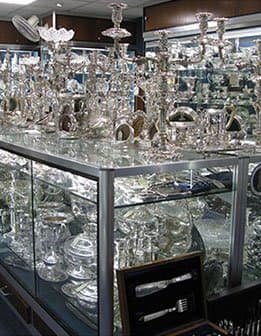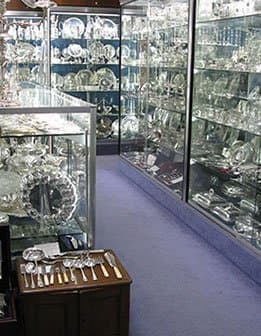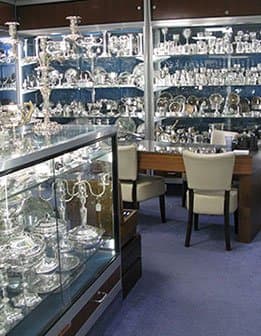How to Assess the Value of Silver Flatware
When assessing the value of silver flatware there are numerous factors to be considered. Probably the most obvious and important is to establish that it is indeed silver and not silver plated or composite metal. One often hears advice such as look at the lion passant for English silver or see if it has a .925 mark, but often even such basic advice can be fraught with difficulties. For example the .925 mark is pretty much non-existent on English flatware before the 21st century (it tends to be used on flatware of American or Canadian origin from the mid-19th century onwards). Scottish flatware uses a thistle mark and Irish uses a harp.
Using an Expert Valuer to Determine Authenticity
To add to confusion, the silver platers often used a huge variety of marks which can look like silver marks to the unwary and one sees a huge amount of flatware on the internet described as silver when it most certainly is not.
The most important thing in establishing the value of ones flatware is to determine what it is and, the only true way is to get it expertly appraised by a specialist.
A general antique valuer is often worse than useless (a little bit of knowledge can sometimes be more dangerous than knowing nothing), rather in the same way you would not want a brain surgeon working on your knee ligaments and vice versa – despite them both being surgeons! So many factors need to be taken into consideration.
What’s the Value of a Silver Spoon?
To demonstrate the difficulties, I will share with you a personal story from about 20 years ago. I was called to do a valuation by a family who had inherited a large amount of silver flatware and wanted an idea of it is worth and how to split that value fairly between the various family members. They had many hundreds of pieces with the family crest of a famous 19th century general who was their ancestor.
Unfortunately, due to the fact that he was in the army and out in India it was in fairly worn condition (the servants at the time tended to clean very aggressively with rough compounds and several times a day!) In fact, it was so worn that the only valuation I could apply was essentially its silver content which at the time – in 2000 – was around £3 per ounce compared to today’s £16. On one hand they were disappointed, but then on the other hand the valuation was for probate (this meant they would pay less tax than they thought).
As I was almost about to leave, I asked them if they had inherited any other silver. One family member said that there was a box of silver plated teaware and a few bits for sewing. I opened the box, and they were right about that, but among the boxes content was an approx. six-inch size spoon weighing less than one ounce (silver value £2-3 at the time). It had no marks just a single relatively obscured stamp to the upper part to the front of the bowl. I immediately recognised it as a very rare diamond point spoon from the late 14th century (around 1380).
Now when it came to value, they were shocked. I told them it was worth about £10,000 which was three times as much as the rest of their silver combined was worth (now the family arguments started as you can imagine!)

I valued it for probate at about £7,000 (a probate valuation is essentially the lowest realisable valuation of an asset). If they wanted to keep the spoon, I would have advised them to insure it for about £15,000. In the end they sold it at Christies where it fetched an all-in price (including commissions) of £13,500, of which the family would have received just over £10,000 (commission is taken from the buyer today at 25 percent plus vat and the seller at 10 percent plus vat). The auction houses essentially take – with insurance as well – nearly 40 percent of the total. That story should demonstrate how difficult it would be for a layman to value their flatware.
Even, for example, if you had two seemingly identical forks made in 1820 one by a London maker such as William Chawner and one by the Royal Goldsmith Paul Storr – the one with the Paul Storr mark would be worth more than twice that of the William Chawner fork (even more perverse as that the Chawner workshop would make much of Paul Storr’s flatware). The art market and that includes silver prizes a famous name.
One could have two identical family paintings both bought at the same time, say for example Van Gogh but only one was ever signed. The one with the signature will be worth many times that of the unsigned one. Even within the same maker, for example different patterns would command different prices. A pattern such as Coburg which is synonymous with Paul Storr would command a much higher price than a kings pattern canteen by him. A difference of object can make a large difference.
For example, any forks from the workshop of the famous lady silversmith Hester Bateman (c. 1780) would be worth much more than her spoons as they are far rarer. There are many collectors of provincial silver in the world and values for these pieces are high if the piece comes from a rare place.
If one had three identical spoons but one was made in Dublin, one in Cork and one in Limerick – the Limerick spoon could be worth tenfold the Dublin example – and to make matters worse for the amateur there are generally no date letters and nothing necessarily even to indicate that it’s even silver. So, I hope I have not disheartened anyone who is considering collecting but keen study and observation of subtle nuances can be picked up relatively quickly by a keen eye.
Should You Clean Your Silver Before Evaluation?
One other point should be noted with regards to cleanliness of an object. Whilst silver is at its best when it is clean and sparkling (although when dealing with very early pieces, say for example pre 1700, one would hope that real care was taken) it is often easier for a collector to make an informed decision when the piece is a bit dirty and tarnished.
Repairs and solder marks and things like erasures are sometimes easier to spot when the item is rather filthy.
I sometimes go to do valuations where people say they’re sorry they haven’t cleaned it (that’s fine!) or I’ve spent the day cleaning, and when you’re gone I will put it back in storage (shouldn’t have bothered).
Here at William Walter Antiques, we are always willing to help our clients identify that mystery piece.
Our Makers
An A to Z list of silversmiths featured on our website
About Us
If you see something in Archive that you would have liked please contact us as we might be able to source
Our Store
Our store is situated in vaults 3 and 5 on the right-hand side of the main corridor at The London Silver Vaults



